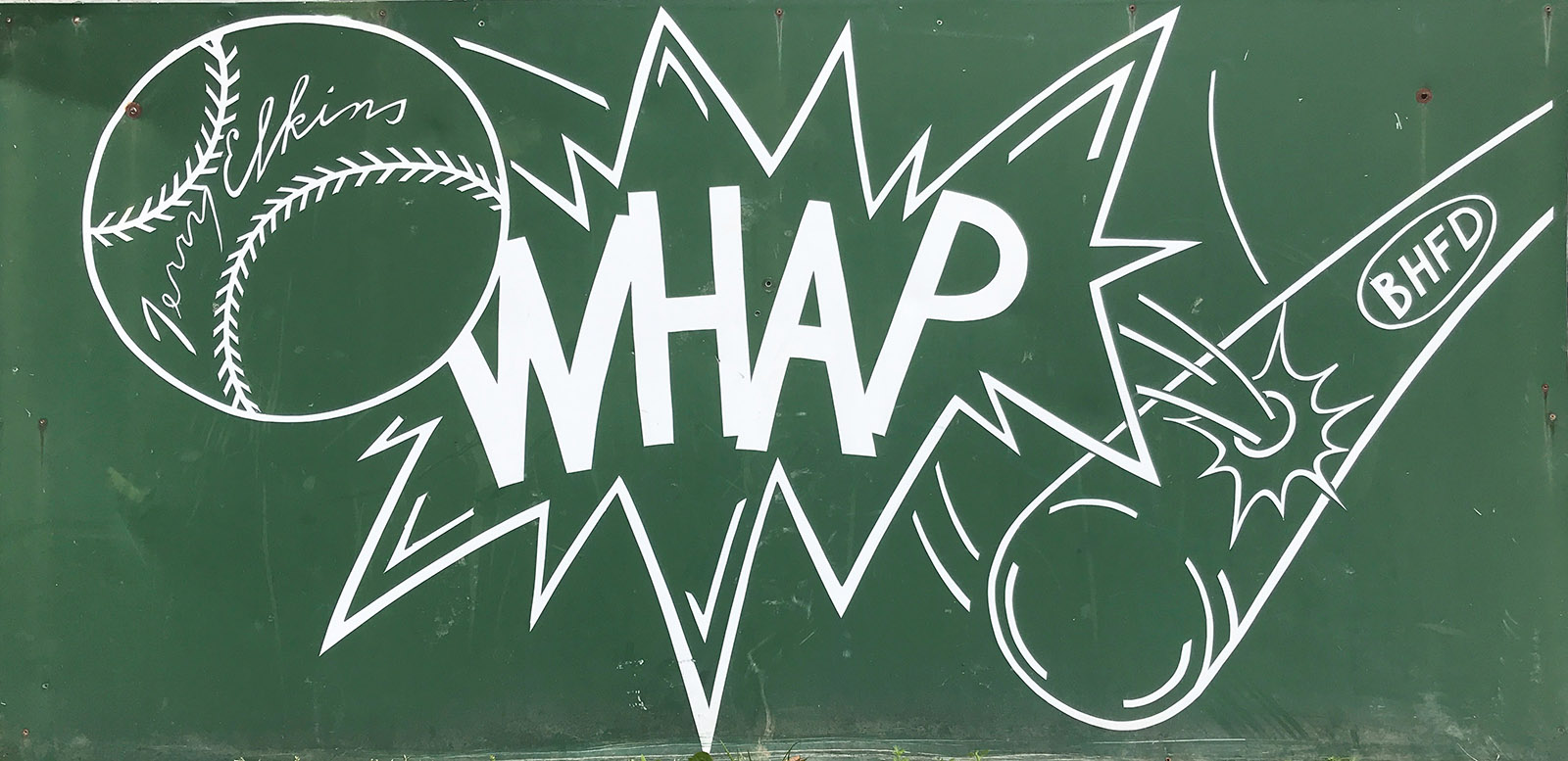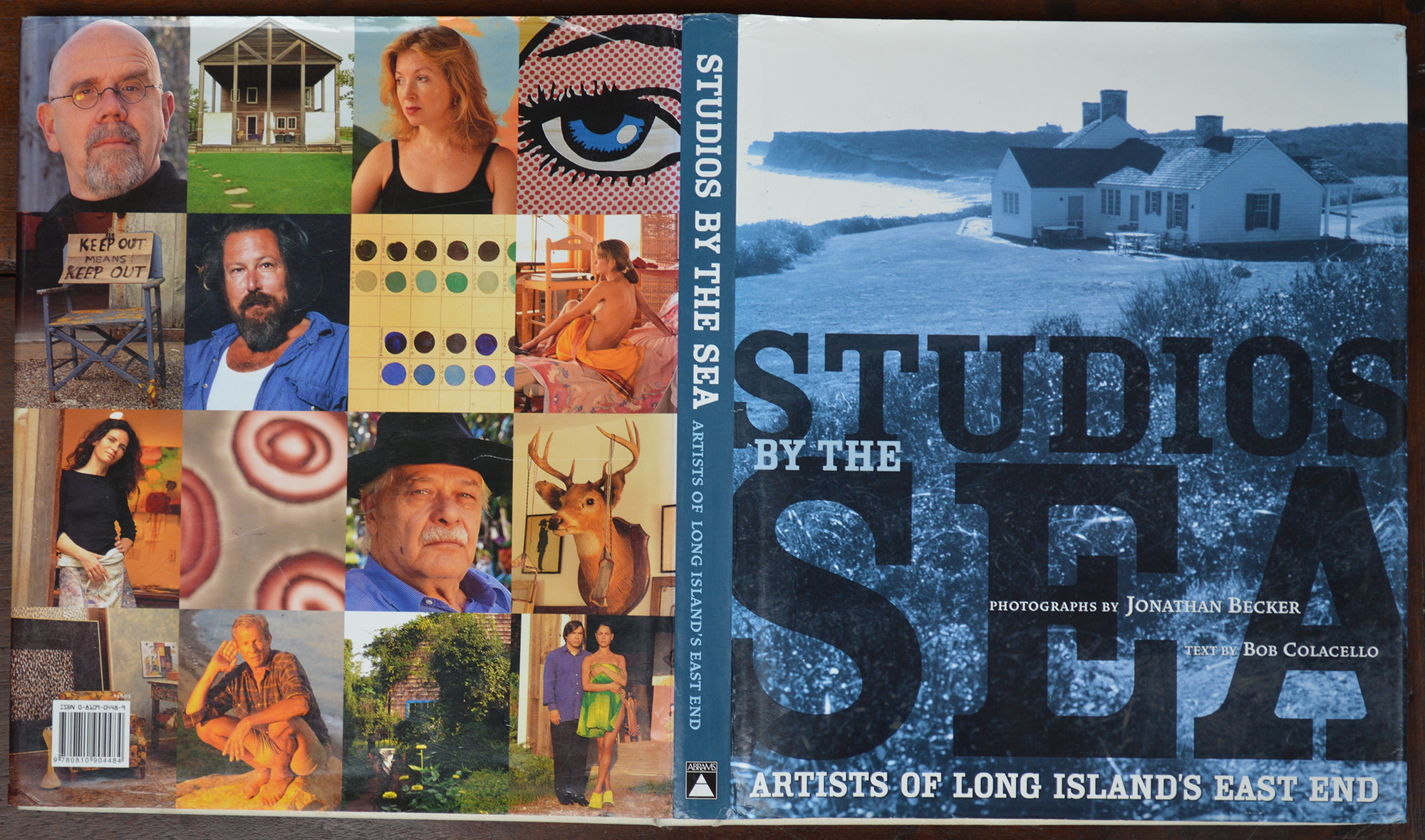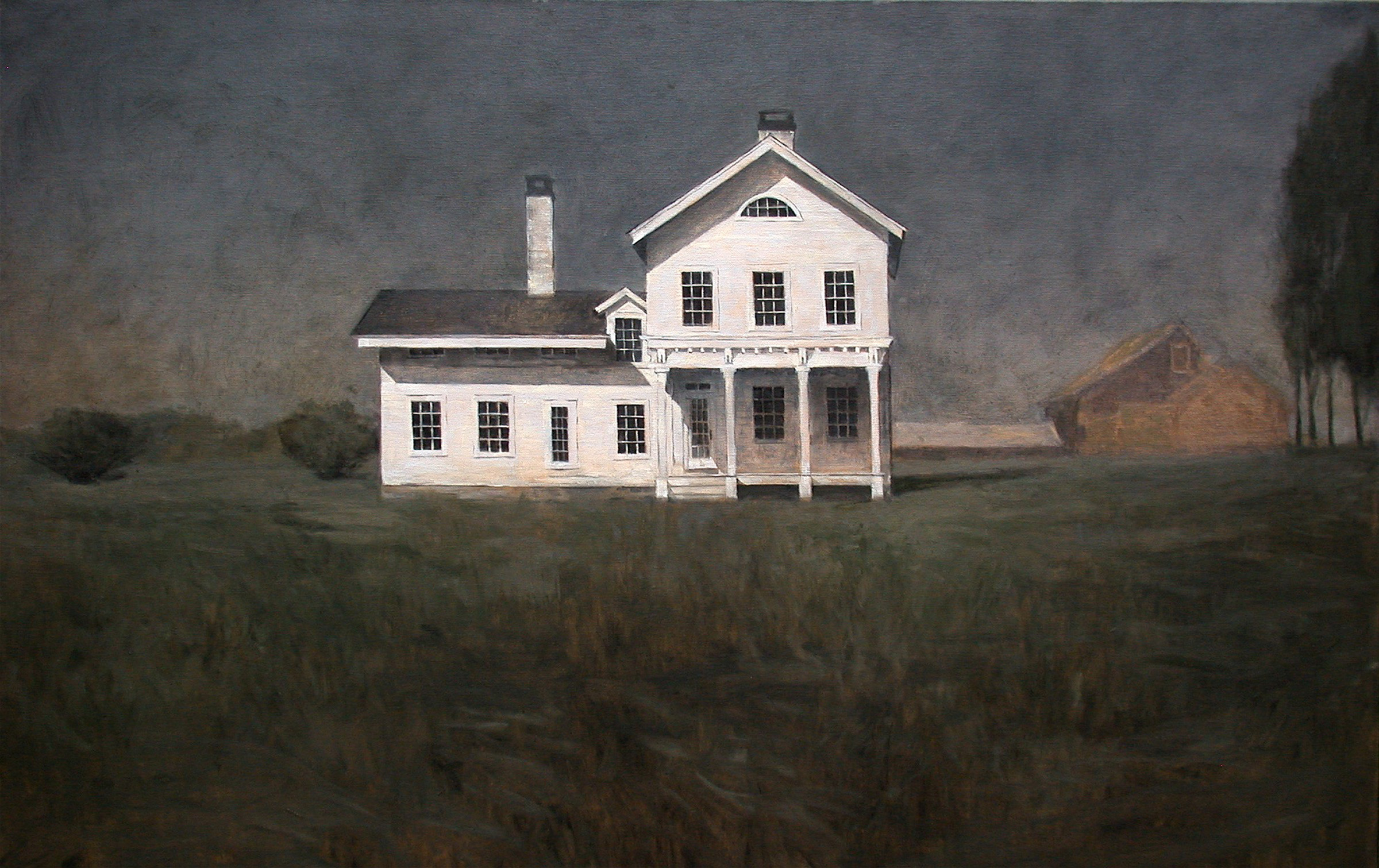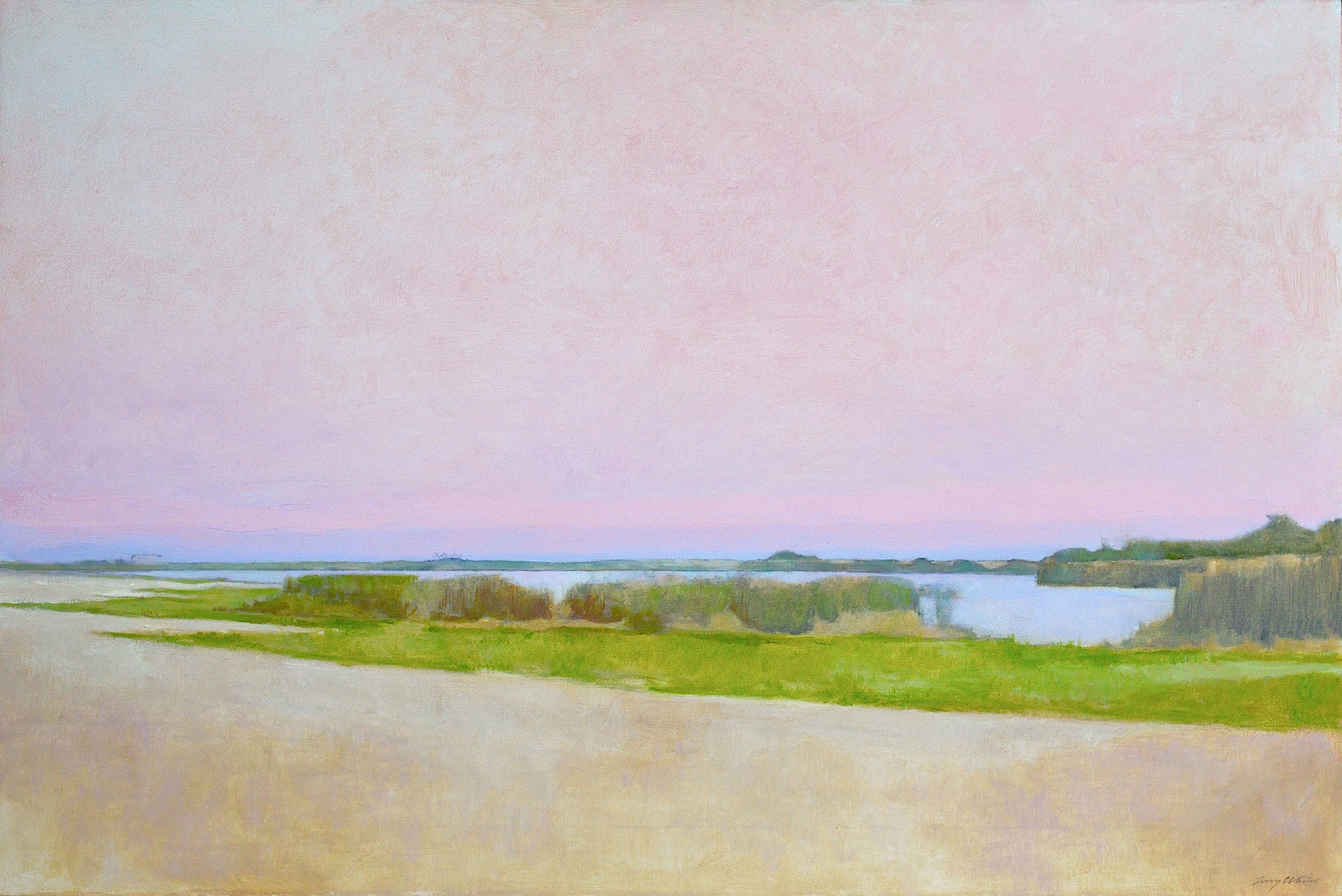
Strong’s Barn, watercolor, 18″x24″
Most of the countryside around Strong’s barn is still farmland. The barn was still being used last year to store potatoes but I’ve noticed a for sale sign posted. Peter Dankowski who’s family has been living and working there for several generations still farms the land around here. This barn and others like it have a long footprint so trucks can bring potatoes from the field, back in and unload. They’re piled to the upper level floor joists, 10′-12′ high, from back to front during harvest. There are two levels, the lower for trucking in the potatoes. The lower half of the structure is set into the earth and the upper level roof slants downward on both sides almost to the ground. The dirt around the outside is pushed up against thick cinder block walls to just below the eaves of the roof and graded down and away from the building so the rains sheds away. It keeps the lower level of the building a little drier. Most of the East End has a constant ground temp below the permafrost line or about six feet deep of about 50˚ year round. That maintains an even temperature year round inside the lower level and helps keep the harvested crop of potatoes at a non perishable temperature. Crops brought in early need to be stored while the rest of the fields are being harvested.
 The landscape around the barn reminds me of what it used to look like before the big homes started going up. At one time land wasn’t expensive but since I’ve lived here it’s value has skyrocketed. Farmers have sold some small parcels off which has helped them financially and saved enough land for themselves to keep farming. Farming is a risk-taking business and, like making art, some years are better than others. I can’t blame a farmer for selling a couple of acres of land for a few million dollars if he needs the money to buy new equipment or build a new barn. But bit by bit new homes have filled in the rural landscape. Some families have turned to organizations like the Peconic Land Trust and donated land in order to preserve the open space and a way of life that has existed for hundreds of years here. There’s a large piece across from the barn that has been preserved so we hope this landscape stays undeveloped as long as possible.
The landscape around the barn reminds me of what it used to look like before the big homes started going up. At one time land wasn’t expensive but since I’ve lived here it’s value has skyrocketed. Farmers have sold some small parcels off which has helped them financially and saved enough land for themselves to keep farming. Farming is a risk-taking business and, like making art, some years are better than others. I can’t blame a farmer for selling a couple of acres of land for a few million dollars if he needs the money to buy new equipment or build a new barn. But bit by bit new homes have filled in the rural landscape. Some families have turned to organizations like the Peconic Land Trust and donated land in order to preserve the open space and a way of life that has existed for hundreds of years here. There’s a large piece across from the barn that has been preserved so we hope this landscape stays undeveloped as long as possible.
Strong’s barn is set into a gently sloping terrain where one field slopes about 20’ down over a few hundred feet to another field. The perfect spot for a potato barn. Not that long ago Wainscot Hollow Rd was a dirt road. One field rolled into the another. Now the road’s paved. The junipers have grown large around the barn over time and one last migrant shack still stands nearby in spite of the storms and wind we have here. It was used to house migrant workers who helped with the harvest. It’s overgrown with vines and weeds, the door is missing, the window sashes to the left and right of the chimney are falling apart, still barely in their frame.

Migrant shack
It’s small, not more than 400 sq.’ I’ve fantasized about buying the shack, renovating it and living there just so I could say I lived in the smallest house in Wainscott. The houses in close proximity are at least 6-7,000 sq’ each. There’s a old crab apple tree growing there too. It’s one of those places nearby that doesn’t take much time or energy to get to or set up to paint. It’s on a street without much traffic and very little development around it and about a mile from my studio. I’ve painted there for years and love that spot. The building itself seems to have a soul of it’s own, alive in the summer, hibernating in the winter. I feel comfortable working there. Not too many cars pass by. Occasionally someone will stop to see what I’m doing. This barn speaks to me without words. It is a patient model that sits quietly still for hours without complaint. But the property is up for sale, and unfortunately I can’t afford to buy it or I would. It’s priced well into the millions and in a most desirable and prestigious location. Still it would make the perfect artist studio. It would be a tragedy to see it razed and some monstrosity built in it’s place. I’ve seen that happen all too often around here. I’ve driven by this barn more times than I can count, just to see what it looks like in different light or times of the day or to see a change of shadow that wasn’t present earlier. Unlike other places I’ve worked, I’ve

Wainscott Winter, oil on linen, 32″x52″, private collection
also painted here year round. In the summer I use my garage, now my workshop, as a painting studio. I can hang as large a canvas as I’d like to do on the wall. The light is good and since I don’t particularly enjoy the fumes of oil paints there’s plenty of fresh air. I keep all my gear handy so when I want to paint somewhere on location I can quickly load up the jeep with all my gear and head out. Last fall I’d been working on another Strong’s Barn painting for several days non stop. I was painting there one morning and came home for a break. In the afternoon I reloaded my gear in haste to go back. I parked in the exact spot as before, set up my folding table and easel, laid out my paints and brushes and then realized I must have forgotten my palette. Could have sworn I brought it. No problem. I left everything right where it was by the side of the road with a note saying, ”Be rite back!” and drove back to the studio to retrieve my necessary tool. It still had the wet paint from that morning. But when I got home it was nowhere to be found. I had this sinking feeling as I realized I’d put it on the roof of my car while I was loading up and forgot it was there. I drove back to the barn hoping it had blown off on the side of road and I’d find it. I did but it was lying in the middle of Hwy 27. It slid off the roof where I had crossed the highway. It’s now 4:00, the cars and trucks are flying by in both directions. I pull over to park, get out and wait, and wait, and finally I make a mad dash to pick it up.

Broken Palette now retired
Honestly, I felt a little embarrassed for being that forgetful, not to mention running out into the road like some crazy person. I probably used a few choice words to describe my own stupidity when I got back in the car. Anyone passing by didn’t realize what I was doing but one of our neighbors who just happened to be driving by at that moment saw me and sent my wife a text wondering if that was me running across the highway. There was one large tire track pressed into the paint and it my palette was broken in a couple of places. Any fresh paint that was left over from the morning was now squished into the tread of someone’s radials. Ugh! I got back to Strong’s barn and tried to forget about it. I scraped down what paint was left, wiped off the tread marks and road grime with a little turp and continued to work. But every time I’d grab some color with my brush there was a tread mark to remind me – don’t leave things on the roof of your car and drive off. Well, at least I was painting. When I got home I did a quick repair and used it for the rest of the summer.

Inscription on the back of a damaged palette
The end of the summer turned into fall. The change happens rapidly on the East End. One day you’re walking barefoot on the beach, a month later you’re shoveling snow and scraping ice off your windshield. Within a few weeks the leaves of the crabapple tree had dried up and fallen off. The grass in the fields began to turn brown as the weather turned colder. Summer was a distant memory. Too many things were going on and I didn’t have the time or inspiration to finish what I’d started. Life gets in the way and time flies by. Fall turns to winter and it’s incredibly difficult to work outside although I try. That’s not a bad thing though. The next piece might take on another direction than where I was going before I set the last one aside. I might see something I didn’t notice last summer. The light will change, I might catch it on a foggy day or an early morning. I’ll drive by there again just to look and think about starting another piece.
 Wainscott Winter, pastel on paper, 22′ x 28″, private collection
Wainscott Winter, pastel on paper, 22′ x 28″, private collection
 Wainscott, oil on linen, 35″ x 52″, private collection
Wainscott, oil on linen, 35″ x 52″, private collection






